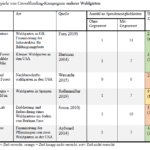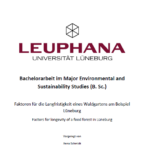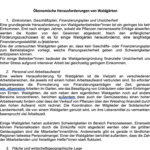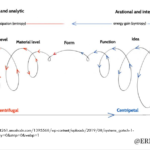Forschung

Wissenschaftliche Arbeiten über nachhaltige Waldgärten
Auf dieser Seite findest du wissenschaftliche Arbeiten von Studierenden der Leuphana Universität Lüneburg und anderen Hochschulen, die rund um das Thema nachhaltige Waldgärten und deren Umsetzung informieren. Am Ende dieser Seite findet ihr eine Liste an wissenschaftlicher Literatur zu Waldgärten.
- Die Finanzierung nachhaltiger Waldgärten am Beispiel des Lüneburger Waldgartens (Bachelorarbeit)

Von Mercedes Schröder (2020)

Welchen Finanzierungsbedarf und welche Finanzierungsmöglichkeiten gibt es für die Initiierung von Waldgärten? Diese Bachelorarbeit untersucht die Umsetzungskosten von Waldgärten und erstellt ein Fundraising-Konzept am Beispiel eines Waldgartens in Lüneburg.
- Faktoren für die Langfristigkeit eines Waldgartens am Beispiel Lüneburg (Bachelorarbeit)

Von Anna Schmidt (2020)

Welche Faktoren unterstützen das langfristige Bestehen von Waldgärten? Was können wir daraus für einen zukünftigen Waldgarten in Lüneburg lernen? Diese Bachelorarbeit untersucht bestehende Waldgärten (Voedselbos Vlaardingen, Voedselbos Ketelbroek, Den Food Bosch und Beacon Food Forest) und relevante Literatur, und leitet daraus Faktoren für Langfristigkeit ab. Dies sind u.a. die Zusammensetzung des Kernteams, ihr Zeitmanagement und ihre Vision, sowie die Öffentlichkeitsarbeit und langfristige Finanzierung.
- Ökonomische Herausforderungen & Lösungsansätze von Waldgärten

Von Johanna Liebmann und Fiona Hasenbach (2020)

Viele Waldgartenbetreibende sind mit ökonomischen Herausforderungen konfrontiert, zu denen es auch zahlreiche kreative Lösungsansätze gibt. Diese Arbeit untersucht dreizehn deutsche und niederländische Waldgärten mit verschiedenen Schwerpunkten. Sie zeigt häufige Herausforderungen und mögliche Lösungsansätzen aus jeweils anderen Waldgärten auf.
- Das Potential von Waldgärten-Wissen einer städtische Gesellschaft zu vermitteln

Von Nicola Schmidt und Marlene Pappenberger (2020)

Die städtische Gesellschaft entfremdet sich zunehmend von Natur und Umwelt. Naturerfahrungen und Umweltwissen sind jedoch eine wichtige Voraussetzung für eine nachhaltige Entwicklung. Diese Arbeit beschäftigt sich mit Bildungsmaßnahmen und -methoden in Waldgärten sowie Indikatoren zur Messung von deren kognitiven, evaluativen und motivationalen Einfluss.
- Philosophie & Prinzipien syntropischer Waldgärten

Von Kristina Kaden (2020)

Der Ansatz des Syntropic Farming, auch sukzessionale Agroforstwirtschaft genannt, bietet eine produktions-orientierte Design- und Management-Methode, die im deutschsprachigen Raum kaum bekannt und insgesamt wenig wissenschaftlich aufbereitet ist. Diese Arbeit fasst die Philosophie und Prinzipien kurz zusammen.
Wissenschaftliche Arbeiten zu Waldgärten
Albrecht, S., & Wiek, A. (2021). Food Forests – Their Services and Sustainability. Journal of Agriculture, Food Systems and Community Development, 10(3), 91–105. https://doi.org/10.5304/jafscd.2021.103.014
Albrecht, S., & Wiek, A. (2021). Implementing Sustainable Food Forests – Extracting Success Factors Through a Cross-Case Comparison // Implementing sustainable food forests: Extracting success factors through a cross-case comparison. Journal of Agriculture, Food Systems and Community Development(11 (1)), 183–200. https://doi.org/10.5304/jafscd.2021.111.019
Albrecht, S., & Wiek, A. (2020). Implementing Sustainable Food Forests – A Transfer Workshop for Stakeholders in Arizona. Sustainable Food Economy Lab, School of Sustainability, Arizona State University, Tempe, Arizona. https://web.asu.edu/slfee/publications-0
Belcher, Brian; Michon, Genevieve; Angelsen, Arild; Ruiz Pérez, Manuel; Asbjornsen, Heidi (2005): The socioeconomic conditions determining the development, persistence, and decline of forest garden systems. In: Economic Botany 59 (3), S. 245–253. Online verfügbar unter https://doi.org/10.1663/0013-0001(2005)059[0245:TSCDTD]2.0.CO;2.
Bukowski, Catherine (2016): Community Food Forests in the United States. Overview and Implications for Urban Agroforestry. Agroforestry in Action Webinar. Virginia State University, Polytechnic Institute. The Centre for Agroforestry, University of Missouri, 16.11.2016. Online verfügbar unter https://agroforestry.adobeconnect.com/p7mrruusg1v/?launcher=false&fcsContent=true&pbMode=normal, zuletzt geprüft am 03.01.2017.
Bukowski, Catherine; Munsell, John (2018): The Community Food Forest Handbook. How to Plan, Organize, and Nurture Edible Gathering Places: Chelsea Green Publishing.
Chazdon, Robin L.; Brancalion, Pedro H. S.; Laestadius, Lars; Bennett-Curry, Aoife; Buckingham, Kathleen; Kumar, Chetan et al. (2016): When is a forest a forest? Forest concepts and definitions in the era of forest and landscape restoration. In: Ambio 45 (5), S. 538–550. DOI: 10.1007/s13280-016-0772-y.
Clark, Kyle H.; Nicholas, Kimberly A. (2013): Introducing urban food forestry. A multifunctional approach to increase food security and provide ecosystem services. In: Landscape Ecol 28 (9), S. 1649–1669. DOI: 10.1007/s10980-013-9903-z.
Ford, Anabel; Nigh, Ronald (2009): Origins of the Maya forest garden. Maya resource management. In: Journal of Ethnobiology 29 (2), S. 213–236.
Hammarsten, Maria; Askerlund, Per; Almers, Ellen; Avery, Helen; Samuelsson, Tobias (2019): Developing ecological literacy in a forest garden: children’s perspectives. In: Journal of Adventure Education and Outdoor Learning 19 (3), S. 227–241. DOI: 10.1080/14729679.2018.1517371.
Hills, Theo L. (1988): The Caribbean food forest, ecological artistry or random chaos. In: Small farming and peasant resources in the Caribbean, S. 1–28.
Huang, Yuanyuan; Chen, Yuxin; Castro-Izaguirre, Nadia; Baruffol, Martin; Brezzi, Matteo; Lang, Anne et al. (2018): Impacts of species richness on productivity in a large-scale subtropical forest experiment. In: Science 362 (6410), S. 80–83.
Kumar, B. M.; Nair, P. K.R. (2006): Tropical homegardens: Springer.
LeGuin, Ursula K.; Home, Always Coming (2011): Edible Forest Gardens. An Invitation to Adventure. In: FOOD and DEMOCRACY, S. 109.
McLain, Rebecca; Poe, Melissa; Hurley, Patrick T.; Lecompte-Mastenbrook, Joyce; Emery, Marla R. (2012): Producing edible landscapes in Seattle’s urban forest. In: Urban Forestry & Urban Greening 11 (2), S. 187–194.
Park, Hyeone; Higgs, Eric (2018): A criteria and indicators monitoring framework for food forestry embedded in the principles of ecological restoration. In: Environmental monitoring and assessment 190 (3), S. 113. DOI: 10.1007/s10661-018-6494-9.
Poveda, Candela Vargas (2016): Facilitating Temperate Forest Garden Development. http://permakultur-danmark.dk/wp-content/uploads/2012/11/Mst.Thesis-Candela-Vargas.pdf
Sass, R., Ferguson, M. S., Toensmeier, E. (Hg.) (2014): Perennial Agriculture Now. A Global Review of Existing Perennial Staple Crops By Climate Region and Nutrient Profile. American Society of Agronomy Annual Meeting.
Sholto Douglas, James; Hart, Robert A. de J. (1984): Forest farming. Towards a solution to problems of world hunger and conservation: Westview Press. Online verfügbar unter https://doi.org/10.3362/9781780442228.
Toensmeier, Eric (2016): The carbon farming solution. A global toolkit of perennial crops and regenerative agriculture practices for climate change mitigation and food security. White River Junction, Vermont: Chelsea Green Publishing.
Toensmeier, Eric (2017): Perennial staple crops and agroforestry for climate change mitigation. In: Integrating Landscapes: Agroforestry for Biodiversity Conservation and Food Sovereignty: Springer, S. 439–451. Online verfügbar unter https://doi.org/10.1007/978-3-319-69371-2_18.
Tupper, Jacquelyn; Tang, Christine; Sheppard, Patrick; Rodgers, Jonathan: Forest Gardening. Redesigning Modern Agriculture.
Vargas Poveda, C. (2016): Facilitating Temperate Forest Garden Development. Creating Tools through Participatory Action Research. MSc thesis in Nature Management. University of Copenhagen, Copenhagen.
Wiersum, K. F. (2004): Forest gardens as an ‘intermediate’land-use system in the nature-culture continuum: characteristics and future potential. In: New Vistas in Agroforestry: Springer, S. 123–134.
Wiek, A., & Albrecht, S. (2022). “Almost there” – on the importance of a comprehensive entrepreneurial ecosystem for developing sustainable urban food forest enterprises. Urban Agriculture & Regional Food Systems., 7(1). https://doi.org/10.1002/uar2.20025